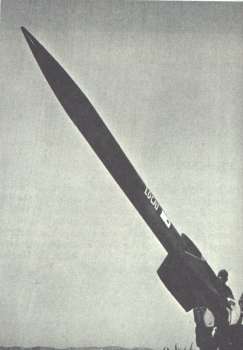Philco-Ford LOCAT
The LOCAT (Low-Cost Aerial Target), developed and built by the Aeronutronics Division of Philco-Ford, was a very low-cost high-speed rocket-powered target for U.S. Army air-defense training. In 1969, Ford received an Army contract for a small test and evaluation quantity of LOCAT rockets. LOCAT was apparently not procured for service use, possibly because the more versatile MTR-15A BATS (Ballistic Aerial Target System) was preferred.
 |
| Photo: U.S. Army |
| LOCAT |
LOCAT had a fuselage made of rolled paper tubing, plastic fins, and was coated with aluminum to provide a radar signature suitable for targeting purposes. The target was boosted by three 70 mm (2.75 in) FFAR (Folding-Fin Aircraft Rocket) solid-fuel motors, and was intended to train missile crews for defense against low flying high-speed aircraft.
Specifications
Note: Data given by several sources show slight variations. Figures given below may therefore be inaccurate!
Data for LOCAT:
| Length | 4.57 m (15 ft) |
| Diameter | 0.24 m (9.6 in) |
| Weight | 70 kg (155 lb) |
| Speed | 840 km/h (520 mph) |
| Ceiling | 90-610 m (300-2000 ft) |
| Range | 610-3350 m (2000-11000 ft) |
| Flight Time | 4-24 s |
| Propulsion | 3 FFAR solid-fuel rockets |
Main Sources
[1] R.T. Pretty, D.H.R. Archer (eds.): "Jane's Weapon Systems 1972-73", Jane's, 1973
[2] James J. Haggerty (ed.): "1970 United States Aircraft, Missiles and Spacecraft", National Aerospace Education Council, 1970
Back to Directory of U.S. Military Rockets and Missiles, Appendix 4
Last Updated: 24 October 2002